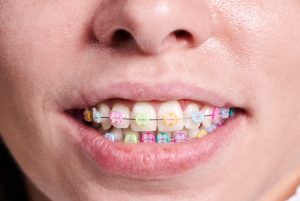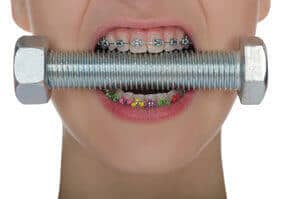Fake braces are trending among teens in some countries where orthodontic treatment is associated with a high-class lifestyle. And as bizarre as it may sound, for some, getting fake braces is just as cool as getting a alternative haircut or a new tattoo. But, what are fake braces and are they safe?
In the majority of cases, these misguided teens are following a social media trend and are seldom aware of how unhealthy this can be.
If you’re a concerned parent or a curious teenager who wants to know more about this trend, read on. In this article, we will dive deeper into artificial braces and the negative effects of wearing them. We will also answer the following questions:
- Can you get fake braces?
- How much do fake braces cost?
- What happens if you wear them?
- What do fake braces do to your teeth?
- Are homemade braces dangerous?
It’s important that we point out straight away, that fake braces will not have the same effect as real dental braces; they are a fashion statement that can go horribly wrong.
Can you get fake braces?
Fake braces are made from a piece of wire with brackets just like traditional metal braces. The materials required can be easily found at home and you will find a lot of DIY videos on social media, like the one below.
As easy as it may sound, you shouldn’t try this at home. Making your own braces might end up causing irreversible damage to your teeth and oral health.
Instead of making them at home, some teenagers buy fake braces online. Usually, they find fake braces for sale online on websites like Amazon or via social media sites Facebook, Instagram and TikTok. Despite major oral health hazards, you’ll find multiple listings selling colourful artificial braces.
What are the reasons for getting DIY braces?
The internet is flooded with videos where teenagers show how artificial dental braces can be made and worn at home, giving dental experts a lot to worry about. Dental experts believe teens are swayed by the following:

It’s trendy
Teenagers see colourful braces as “cool” because braces can make a statement and change the way you look. But genuine coloured braces are often out of their budgets or they don’t really need them. As a result, teens make them at home—without realizing the side effects.
Crooked teeth
Nobody likes to have crooked teeth, but in-clinic teeth straightening options are often too expensive for teenagers with limited resources. So in order to straighten their teeth without braces for a price they can afford, they might start looking at DIY options.
Status symbol
Braces are expensive, and copying what influencers or people with money do is human nature. This can mean that teens with fewer resources might take advantage of this trend in order to appear more affluent or ‘cool’.
Artificial braces can be made with easily available, cheap materials, but they can look as genuine as traditional braces, making DIY braces for teeth an unusual status symbol.
How much do fake braces cost?
Real braces can cost thousands of pounds privately, and not many people qualify for NHS braces, but you can get a fake braces kit for under £100. Homemade braces are even cheaper than online alternatives.
The reason for artificial braces being cheaper is simple—they’re not the real deal. They’re just a fashion accessory for your teeth. So, if you are under the impression that fake braces can actually straighten your teeth, you are mistaken.
Before you consider artificial braces to align your crooked teeth, have a look at this summary of the best kinds of safe teeth straightening options out there:
Type of Straightening | Advantages | Approximate cost |
Metal braces |
| £1,500 – £3,000 |
Ceramic braces |
| £2,000 – £6,000 |
Self-ligating braces |
| £1,500 – £6,000 |
Lingual braces |
| £2,000 – £10,000 |
Invisalign |
| £1,500 – £5,500 |
At-home aligners |
| £1,000 – £1,600 |
If you are looking for safe, effective and affordable ways to straighten your teeth at home, take a look at our guide here.
What happens if you wear fake braces?
Artificial braces have a lot more disadvantages than advantages. According to professionals around the world, they are extremely hazardous with potentially irreversible effects.

- Poisoning from toxic materials: Fake braces for teeth are made from cheap materials that can be toxic. These materials include cheap rubber and metals that contain lead, leading to poisoning and even death in some cases. Also, most of these materials and liable to corrosion in the presence of saliva.
- Choking from material that might get stuck in your throat: When teens make their own braces, the material from the braces may unwind and end up in their throat while sleeping, essentially causing choking.
- Inflammation and infection: Even real braces can lead to some oral issues like inflammation and infection at the early stages. So the risk is even greater with fake teeth braces. In some cases, the infection can get worse and might even require surgery to stop the spread.
- Tooth decay and discoloration: The presence of braces makes oral hygiene difficult to maintain and increases plaque accumulation leading to greater decay risk. Fake braces are also stuck to the teeth using cheap adhesives. This causes serious damage to tooth enamel. The adhesive can also dig deep into the tooth and cause discoloration over time.
- Shifting of teeth: They can cause teeth to shift—but not in the ways you want. You could end up with teeth that were more crooked than you had to begin with. If the forces applied to the teeth were so strong, this could even lead to teeth mobility due to bone loss.
Are fake braces dangerous?
Fake dental braces raise quite a lot of alarms when it comes to health issues. The dangers of this fashion trend are real and can affect your health and have negative effects on your wellbeing.
What’s more, these faux braces have even led to deaths in some countries. Here’s an article from The Bangkok Post that mentions the death of a girl that wore pink fake braces for 2 months reported in Thailand. Upon investigation, authorities found deadly materials like cadmium in the autopsy, as well as severe dental cavities and infected gums.
Health experts across Asia have taken this trend seriously and are working toward creating awareness among teens.
Conclusion
Fake braces that look real are hazardous. The cons completely outweigh the temporary joy of following a social media trend. The problem with artificial braces lies in the materials they are composed of which are often toxic. Fake teeth braces can not only damage your teeth and dental health, they can cost you your life if you aren’t careful.
Modern problems like the artificial braces trend can only be tackled with awareness and education. Health services, parents, and guardians will have to be watchful that children are not making or buying DIY braces. It’s critical to make younger generations understand that no trend is worth risking their health or their lives.
Iopscience. Elemental and microstructural analysis of fake, real, and standard orthodontic brackets. Consulted 22nd April 2020.




